| Home > Policy > White Paper, Notice, Announcement > White Paper > EDUCATIONAL STANDARDS IN JAPAN 1965 > CHAPTER |
||
Apart from public expenditures paid by governmental authorities there are parental expenditures for children's school education. They include those expenditures paid by the parents in order to meet costs of school education for their children, such as tuition, school lunch and other fees, transportation expenses, and expenses incurred for independent study at home.
In 1962, the average sum of yearly parental expenditures for school education per pupil was 10,476 yen at the elementary level, 13,959 yen at the lower secondary level, and 37,077 yen at the upper secondary level. The trends in actual amounts are shown below.
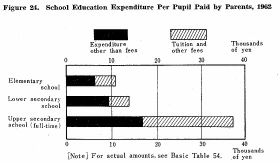
Although parental expenditure on their children's school education has essentially doubled during the past decade, its rate or increase is not so high as that of the national income per capita. In this respect it is noteworthy that, in order to alleviate parental financial burden for their children's education, an amendment of the Local Finance Law has been enacted to prohibit parental contribution to specific school expenditures such as salaries, costs for operation and for maintenance of school buildings and equipment.
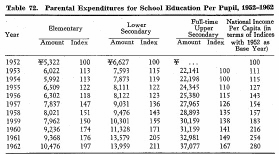
The trend in the percentage of school education costs borne by parents is shown in Table 73. In all the three levels of education, the percentage borne by parents has been decreasing though it is still between one-fourth and ones third of the total cost.
The amounts of parental costs on school education for their children vary among parents with different levels of income. The situation is indicated in Table 74.
Parents with annual income of \2,000,000 or more pay, in average, \13,419 per child enrolled in elementary school, and \15,947 per child enrolled in lower secondary school. Both the amounts exceed the national averages. On the other hand, parents with annual income of \400,O00-\600,000 spend \10,104 per child enrolled in elementary school, and \13,710 per child enrolled in lower secondary school. But the percentage of parental income spent on education is much higher for parents with income of \400,000-\600,000 than for those with income of \2,000,000 or more.
In addition to children's "school education costs" mentioned above, parents in general pay a certain amount of money for children's home education. Such "home education costs" have been increasing at a higher rate than the national income per capita. The rate of increase in expenditures for home education is particularly high for children enrolled in elementary schools.
*"Home education costs" include expense for preparation and review for the classroom work and other study at home, expense for developing general culture of children, expense for out-of-school physical training, fees paid to youth organizations, and expense for the purchase of durable goods used for children's education.
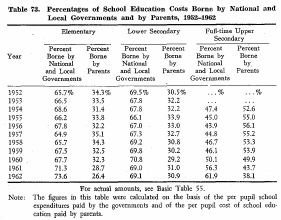
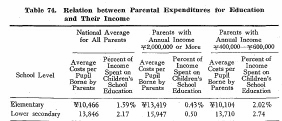
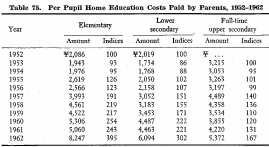
| Back to Top | MEXT HOME |